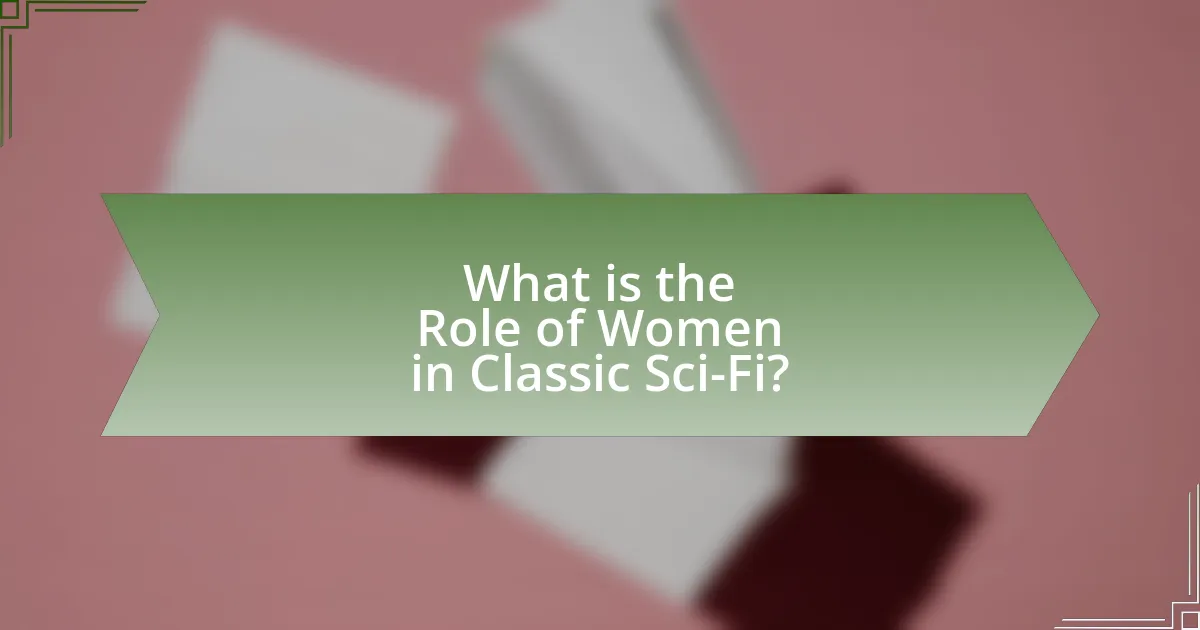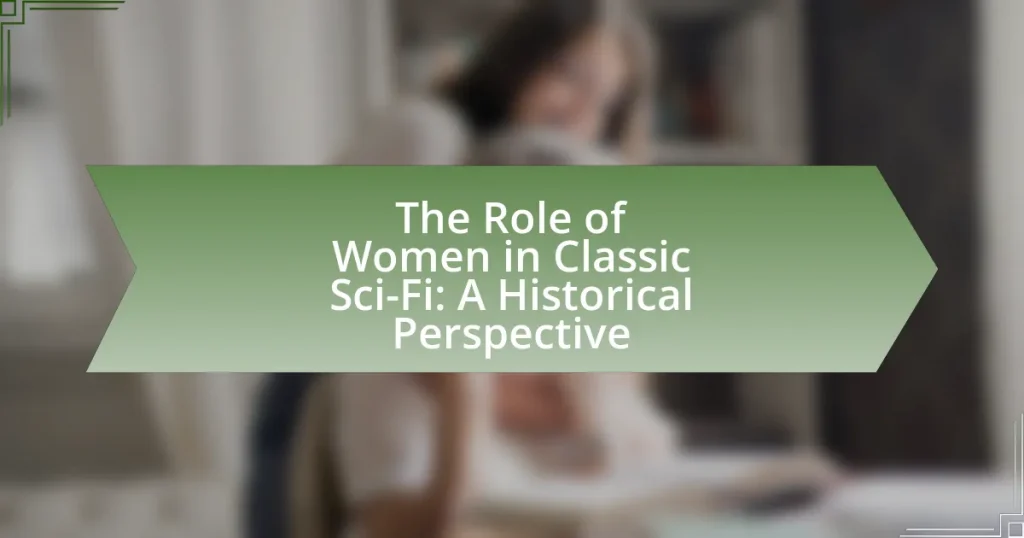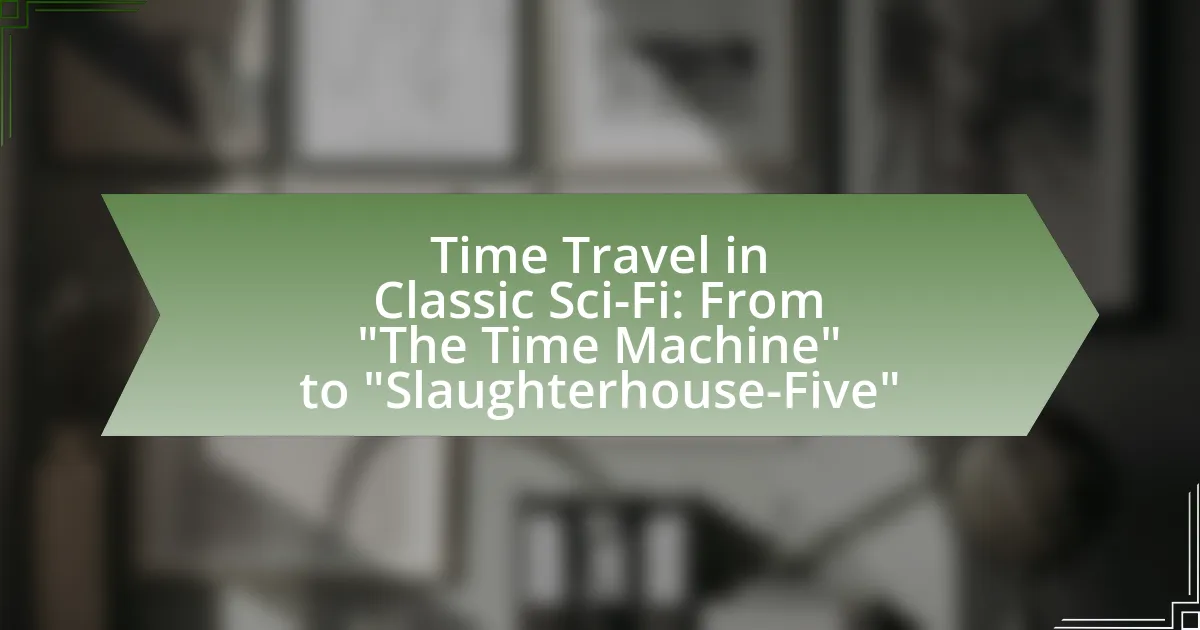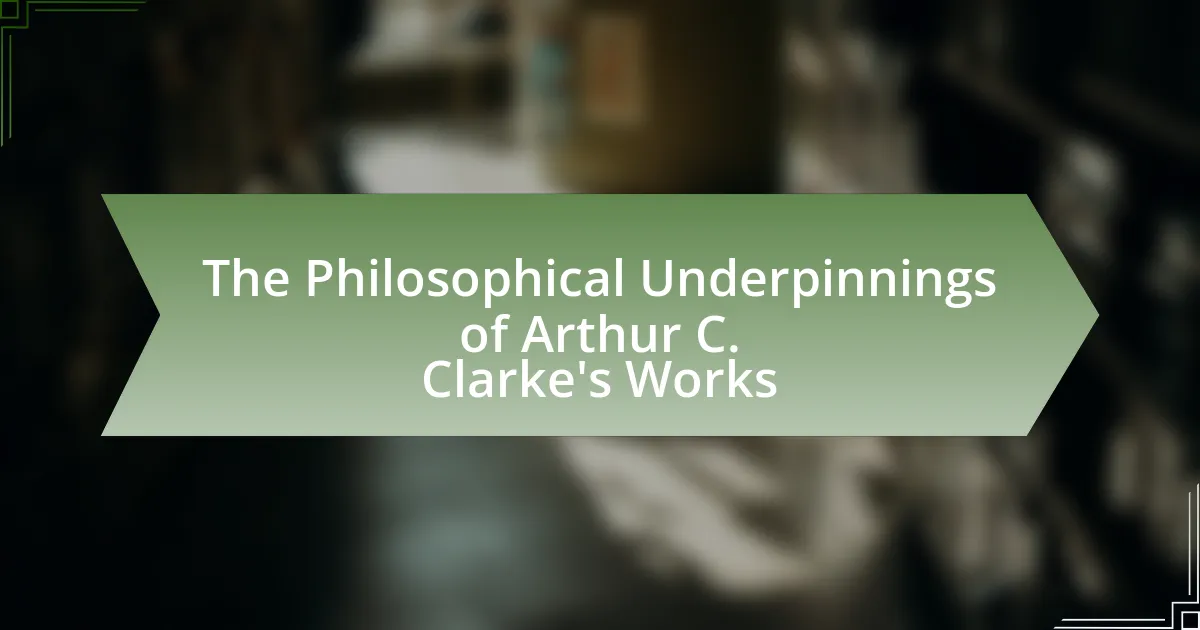The article examines the role of women in classic science fiction, highlighting their portrayal as secondary characters in early works, often lacking agency and depth. It discusses the evolution of female representation from stereotypical roles to complex protagonists, particularly through the contributions of authors like Ursula K. Le Guin and Octavia Butler. The analysis also explores the historical contexts that influenced these portrayals, the impact of feminist movements, and the significance of female authors in reshaping the genre. Key themes include empowerment, oppression, and the societal views reflected in classic sci-fi narratives, providing insights into the ongoing discussions about gender representation in contemporary science fiction.

What is the Role of Women in Classic Sci-Fi?
The role of women in classic sci-fi often depicted them as secondary characters, typically serving as love interests or damsels in distress. For instance, in works like Isaac Asimov’s “Foundation” series and Arthur C. Clarke’s “2001: A Space Odyssey,” female characters frequently lacked agency and depth compared to their male counterparts. This trend reflected broader societal norms of the time, where women’s roles were largely confined to domestic spheres. Additionally, female authors like Ursula K. Le Guin and Octavia Butler began to challenge these stereotypes, introducing complex female protagonists and exploring themes of gender and power, thereby reshaping the genre.
How has the portrayal of women evolved in classic sci-fi literature?
The portrayal of women in classic sci-fi literature has evolved from predominantly passive and stereotypical roles to more complex and empowered characters. Early works, such as those by H.G. Wells and Isaac Asimov, often depicted women as secondary figures, primarily serving as love interests or damsels in distress. For instance, in Asimov’s “Foundation” series, female characters are largely absent or lack agency.
In contrast, later classic sci-fi literature, particularly from the 1970s onward, began to feature women in more active and significant roles. Authors like Ursula K. Le Guin and Octavia Butler introduced female protagonists who challenged societal norms and exhibited agency. Le Guin’s “The Left Hand of Darkness” presents a society where gender roles are fluid, while Butler’s “Kindred” explores themes of race and gender through a strong female lead.
This shift reflects broader societal changes regarding gender equality and women’s rights, indicating that as feminist movements gained momentum, so too did the representation of women in science fiction. The evolution showcases a transition from traditional gender roles to a more nuanced understanding of women’s capabilities and contributions within speculative narratives.
What are the key characteristics of female characters in early sci-fi works?
Key characteristics of female characters in early sci-fi works include being often portrayed as either damsels in distress or as exotic, otherworldly beings. These characters frequently lacked depth and agency, serving primarily to support male protagonists or to embody societal fears and fantasies about women. For instance, in works like “The Time Machine” by H.G. Wells, female characters are depicted as passive figures, while in “A Princess of Mars” by Edgar Rice Burroughs, they are idealized as beautiful and noble but ultimately dependent on male heroes. This pattern reflects the gender norms and cultural attitudes of the early 20th century, where women’s roles were largely confined to traditional expectations.
How do these characteristics reflect societal views of women during the time?
The characteristics of women in classic sci-fi reflect societal views that often portrayed them as subservient or secondary to male characters. During the early to mid-20th century, women were frequently depicted in roles that emphasized domesticity, emotional support, or as objects of desire, mirroring the limited societal expectations of women at that time. For instance, in works like “The Dispossessed” by Ursula K. Le Guin, female characters often lacked agency, reinforcing the notion that women’s primary value lay in their relationships with men. This portrayal aligns with historical contexts where women were largely confined to traditional roles, as evidenced by the lack of female representation in leadership positions and the prevailing belief in women’s primary responsibilities as homemakers.
Why is it important to analyze women’s roles in classic sci-fi?
Analyzing women’s roles in classic sci-fi is important because it reveals how gender dynamics and societal norms have evolved over time. Classic sci-fi often reflects the cultural attitudes of its era, and examining female characters can highlight both progressive and regressive portrayals of women. For instance, works like Ursula K. Le Guin’s “The Left Hand of Darkness” challenge traditional gender roles, while others may reinforce stereotypes. Understanding these representations allows for a deeper comprehension of the genre’s impact on societal views regarding gender, as well as the potential for sci-fi to serve as a platform for feminist discourse.
What impact did these portrayals have on future representations of women in the genre?
The portrayals of women in classic sci-fi significantly influenced future representations by establishing a foundation for more complex and diverse female characters. Early depictions often relegated women to secondary roles or stereotypical archetypes, which prompted later creators to challenge these norms and develop multifaceted female protagonists. For instance, the shift seen in works like “The Handmaid’s Tale” by Margaret Atwood and “Kindred” by Octavia Butler reflects a move towards nuanced portrayals that address themes of agency, power, and identity. This evolution in representation has been documented in scholarly analyses, such as “Women in Science Fiction: A Historical Perspective” by Lisa Yaszek, which highlights how earlier portrayals paved the way for contemporary narratives that empower women and explore their complexities in the genre.
How do these roles influence contemporary discussions about gender in sci-fi?
The roles of women in classic sci-fi significantly influence contemporary discussions about gender by highlighting the evolution of female representation and agency in the genre. Historically, women were often depicted in stereotypical roles, such as damsels in distress or secondary characters, which shaped societal perceptions of gender norms. This legacy prompts modern creators and audiences to critically examine and challenge these outdated portrayals, advocating for more complex and empowered female characters. For instance, the rise of feminist sci-fi authors like Octavia Butler and Margaret Atwood has redefined narratives, emphasizing women’s experiences and perspectives, thereby fostering a broader dialogue about gender equality and representation in contemporary sci-fi.

What are the Historical Contexts Influencing Women in Classic Sci-Fi?
Historical contexts influencing women in classic sci-fi include the societal norms and gender roles prevalent during the early to mid-20th century, particularly the post-World War II era. During this time, women were often relegated to domestic roles, which shaped their representation in science fiction literature. For instance, the 1950s saw a surge in stories featuring women as either supportive figures or as embodiments of futuristic ideals, reflecting the era’s anxieties about gender and technology. Additionally, the feminist movements of the 1960s and 1970s began to challenge these stereotypes, leading to more complex female characters in sci-fi narratives. This evolution can be seen in works by authors like Ursula K. Le Guin and Octavia Butler, who incorporated feminist themes and explored women’s agency in their stories, thus reshaping the genre’s portrayal of women.
How did the socio-political climate of the time shape women’s roles in sci-fi?
The socio-political climate significantly shaped women’s roles in sci-fi by reflecting and challenging contemporary gender norms. During the mid-20th century, particularly in the 1950s and 1960s, the feminist movement began to gain momentum, leading to increased visibility of women’s issues in literature. This period saw female characters evolving from traditional roles, often depicted as passive or secondary, to more complex figures who challenged societal expectations. For instance, authors like Ursula K. Le Guin and Octavia Butler created strong, independent female protagonists that mirrored the growing demand for gender equality and women’s rights. The portrayal of women in sci-fi thus became a vehicle for exploring themes of empowerment and resistance against patriarchal structures, illustrating how the socio-political context directly influenced literary representation.
What major historical events influenced the writing of classic sci-fi?
The major historical events that influenced the writing of classic sci-fi include World War II, the Space Race, and the Cold War. World War II catalyzed technological advancements and societal changes, prompting authors to explore themes of dystopia and human resilience. The Space Race, particularly the launch of Sputnik in 1957, inspired a surge in interest in space exploration and extraterrestrial life, leading to works that reflected humanity’s aspirations and fears about the future. The Cold War fostered a climate of paranoia and existential dread, which was reflected in sci-fi narratives that often addressed issues of totalitarianism, nuclear war, and the ethics of scientific progress. These events collectively shaped the thematic and narrative structures of classic science fiction literature.
How did feminist movements impact the portrayal of women in this genre?
Feminist movements significantly transformed the portrayal of women in classic sci-fi by challenging traditional gender roles and advocating for more complex female characters. In the 1960s and 1970s, the rise of second-wave feminism prompted authors and filmmakers to create female protagonists who were not merely sidekicks or love interests but were central to the narrative, showcasing intelligence, strength, and agency. For instance, works like Ursula K. Le Guin’s “The Left Hand of Darkness” and Octavia Butler’s “Kindred” introduced nuanced female characters that defied stereotypes, reflecting the feminist ideals of equality and empowerment. This shift in representation can be traced to the broader cultural changes initiated by feminist activism, which demanded that women’s experiences and perspectives be authentically represented in literature and media.
What were the common themes related to women in classic sci-fi narratives?
Common themes related to women in classic sci-fi narratives include the portrayal of women as either nurturing figures or as objects of desire, often reflecting societal views of gender roles. In many classic works, such as “The Dispossessed” by Ursula K. Le Guin, women are depicted in supportive roles, emphasizing their nurturing qualities, while in others, like “Fahrenheit 451” by Ray Bradbury, female characters often serve as catalysts for male protagonists’ development. Additionally, themes of empowerment and resistance against patriarchal structures are prevalent, as seen in “The Left Hand of Darkness,” where gender fluidity challenges traditional gender norms. These themes illustrate the complex representation of women, often oscillating between empowerment and objectification, mirroring the evolving societal attitudes towards gender during the time these narratives were written.
How do themes of empowerment and oppression manifest in these stories?
Themes of empowerment and oppression in classic sci-fi stories often manifest through the portrayal of female characters who navigate restrictive societal norms while asserting their agency. For instance, in works like “The Dispossessed” by Ursula K. Le Guin, female characters challenge patriarchal structures, showcasing empowerment through their intellectual and social contributions. Conversely, in “Fahrenheit 451” by Ray Bradbury, the character of Mildred represents oppression, as she is trapped in a conformist society that stifles individuality and critical thought. These contrasting depictions highlight the struggle for autonomy against systemic barriers, illustrating how women’s roles evolve within the genre while reflecting broader societal issues.
What role did women authors play in shaping these narratives?
Women authors played a crucial role in shaping classic sci-fi narratives by introducing diverse perspectives and themes that challenged societal norms. Notable figures such as Mary Shelley, who authored “Frankenstein” in 1818, explored the ethical implications of scientific advancement, while Ursula K. Le Guin’s works, including “The Left Hand of Darkness,” examined gender and sexuality, influencing the genre’s evolution. Their contributions not only expanded the thematic scope of science fiction but also paved the way for future generations of female writers, establishing a legacy that continues to impact the genre today.

What are the Key Works Featuring Women in Classic Sci-Fi?
Key works featuring women in classic sci-fi include “The Left Hand of Darkness” by Ursula K. Le Guin, “A Wrinkle in Time” by Madeleine L’Engle, and “The Dispossessed,” also by Le Guin. These works are significant as they explore themes of gender, identity, and societal structures through female protagonists. For instance, “The Left Hand of Darkness” examines gender fluidity and the impact of societal norms on personal relationships, while “A Wrinkle in Time” features strong female characters who challenge traditional roles. Le Guin’s contributions, particularly in “The Dispossessed,” further highlight the complexities of gender and politics in speculative fiction.
Which classic sci-fi works prominently feature female protagonists?
Classic sci-fi works that prominently feature female protagonists include “The Left Hand of Darkness” by Ursula K. Le Guin, “Fahrenheit 451” by Ray Bradbury, and “The Dispossessed,” also by Le Guin. In “The Left Hand of Darkness,” the protagonist Genly Ai interacts with Estraven, a key character who challenges gender norms. “Fahrenheit 451” features Mildred Montag, who represents the consequences of a dystopian society’s impact on women. “The Dispossessed” centers on Shevek, but also highlights the significant role of female characters like Bedap and their contributions to the narrative. These works illustrate the evolving representation of women in the genre, showcasing their complexity and importance in classic science fiction.
What unique perspectives do these works offer on women’s experiences?
Classic sci-fi works offer unique perspectives on women’s experiences by portraying them in diverse roles that challenge traditional gender norms. For instance, characters like Ursula K. Le Guin’s Genly Ai in “The Left Hand of Darkness” explore themes of gender fluidity and the social constructs surrounding femininity and masculinity. Additionally, in works like “The Dispossessed,” Le Guin presents women as integral to societal structures, emphasizing their contributions to both utopian and dystopian narratives. These portrayals reflect the complexities of women’s identities and roles in society, providing insights into the evolving perceptions of gender during the time these works were written.
How do these stories challenge or reinforce gender stereotypes?
Classic sci-fi stories often reinforce gender stereotypes by depicting women in traditional roles, such as caregivers or romantic interests, which limits their agency and reinforces societal norms. For example, in works like “The Day the Earth Stood Still,” female characters often serve as emotional support for male protagonists, reflecting the mid-20th century view of women as secondary to men. Conversely, some stories challenge these stereotypes by presenting women as strong, independent figures who drive the narrative, such as in “The Left Hand of Darkness,” where Ursula K. Le Guin explores gender fluidity and the complexities of identity. This duality illustrates how classic sci-fi can both uphold and subvert gender norms, reflecting the evolving perceptions of women’s roles in society.
What contributions did female authors make to the classic sci-fi genre?
Female authors significantly shaped the classic sci-fi genre by introducing diverse perspectives and themes that challenged societal norms. Notable contributions include Mary Shelley’s “Frankenstein,” which explored the ethical implications of scientific advancement and the nature of humanity, and Ursula K. Le Guin’s works, which examined gender roles and social structures, particularly in “The Left Hand of Darkness.” Additionally, authors like Octavia Butler brought issues of race and identity into speculative fiction, expanding the genre’s scope. These contributions not only enriched the narrative landscape of sci-fi but also paved the way for future generations of writers, establishing a foundation for discussions on feminism, ethics, and social justice within the genre.
Which female authors are considered pioneers in classic sci-fi?
Mary Shelley, Ursula K. Le Guin, and Octavia Butler are considered pioneers in classic sci-fi. Mary Shelley is renowned for her groundbreaking novel “Frankenstein,” published in 1818, which is often cited as the first science fiction work. Ursula K. Le Guin’s influential works, such as “The Left Hand of Darkness” (1969), challenged gender norms and explored sociopolitical themes within speculative fiction. Octavia Butler, recognized for her unique contributions to the genre, particularly with novels like “Kindred” (1979) and the “Patternist” series, addressed issues of race, gender, and power dynamics. These authors significantly shaped the landscape of science fiction, establishing a foundation for future female writers in the genre.
How did their works differ from their male counterparts?
Women’s works in classic sci-fi often differed from their male counterparts by emphasizing themes of emotional depth, social critique, and the exploration of gender roles. For instance, authors like Ursula K. Le Guin and Octavia Butler focused on the complexities of human relationships and societal structures, often challenging traditional gender norms. In contrast, many male authors tended to prioritize action-oriented plots and technological advancements. Le Guin’s “The Left Hand of Darkness” explores gender fluidity and the impact of societal constructs on identity, while Butler’s “Kindred” examines the intersection of race and gender through time travel. These thematic choices reflect a distinct perspective that diverges from the more conventional narratives typically presented by male authors in the genre.
What lessons can we learn from the role of women in classic sci-fi?
The role of women in classic sci-fi teaches us about the evolving perceptions of gender and societal roles. Classic sci-fi often depicted women in limited, stereotypical roles, such as damsels in distress or secondary characters, reflecting the gender norms of the time. However, some works, like Ursula K. Le Guin’s “The Left Hand of Darkness,” challenged these norms by presenting complex female characters and exploring themes of gender fluidity. This indicates that literature can influence societal views on gender, highlighting the potential for change. Furthermore, the gradual emergence of strong female protagonists in the genre illustrates a shift towards greater representation and empowerment, emphasizing the importance of diverse voices in storytelling.
How can contemporary writers draw inspiration from these historical portrayals?
Contemporary writers can draw inspiration from historical portrayals of women in classic sci-fi by analyzing the complexities and challenges faced by female characters in those narratives. For instance, characters like Leela from “Doctor Who” and the women in Ursula K. Le Guin’s works exemplify strength and agency, which can inform modern character development. These portrayals often reflect societal attitudes towards gender roles, allowing contemporary writers to critique or build upon these themes in their own works. By examining how these historical figures navigated their worlds, writers can create nuanced female characters that resonate with current audiences, reflecting ongoing discussions about gender equality and representation in literature.
What best practices can be adopted to create more inclusive narratives in sci-fi today?
To create more inclusive narratives in sci-fi today, writers should prioritize diverse representation by incorporating characters from various backgrounds, cultures, and identities. This approach not only enriches storytelling but also reflects the complexity of real-world societies. Research indicates that diverse narratives can enhance audience engagement and broaden perspectives, as seen in the success of works like “Black Panther,” which featured a predominantly Black cast and explored themes of identity and heritage. Additionally, involving writers and creators from underrepresented groups in the storytelling process ensures authenticity and depth in character development. By adopting these practices, the sci-fi genre can evolve to be more inclusive and reflective of a diverse audience.




